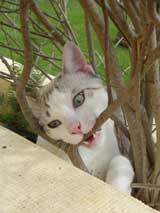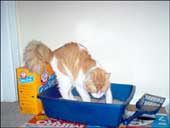My cat's dead the 11 october with cancer, and I'm staying with him until the end.
I miss Benjamin . But it will always remain in my heart
Just like humans, cats feel miserable when they are sick. As a pet owner, it is your primary responsibility to keep your feline friends healthy and happy.
With proper care and nutrition you will have a friend for life in the form of your pet cat.
Here are some tips on how you can properly care for your cat's health:
1. Feed them properly.
Every cat has a preference when it comes to food. There are several types of cat food available in the market. Try each one until you find out which variety your cat prefers.
However, you can still try to mix the variety of cat food you prepare so that your pet will have a nutritious and balanced diet.
Commercial cat foods have been well-researched so you do not need to worry about the nutritional value of what you are feeding your pet.
Also, supply your pet with a lot of clean water to drink. Having an ample supply of drinking water will lead to a healthier animal.
It does not matter if you serve dry, canned or moist cat food. Just make sure that you preserve the freshness of the food that they eat.
You would also want to opt for a healthy and natural cat food. Remember that it should be made of quality ingredients.
2. Remember that even domestic cats are natural hunters.
Mice can serve two purposes in your cat's life: prey and dinner. Hunting for mice would preserve their natural abilities to hunt and seek prey.
If you decide that you do not like the idea of your cat regularly "hunting" for dinner, make sure that you provide them with a proper diet. This will result to your cat ending up just chasing and running after their prey for satisfying their natural hunting urges.
3. Watch out for unusual behavior.
If your pet is exhibiting unusual behavior, then the cat might not be at its best condition.
Try to look out for the following symptoms:
- being lethargic or less active than usual- shedding of the fur or coat- it has waxy ears- looks poor and unhealthy
If you see these symptoms, you might want to change the food that you are serving your cat.
Better yet, consult a professional if you see your pet being less active than usual. Your pet might have a sickness or disease, and as a pet owner and cat lover, you would not want that to happen.
Benjamin memory's site.



 Cat photos "Training "
Cat photos "Training " cat photos " kitten very cute"
cat photos " kitten very cute" and cat photos "Benjamin play"
and cat photos "Benjamin play"










